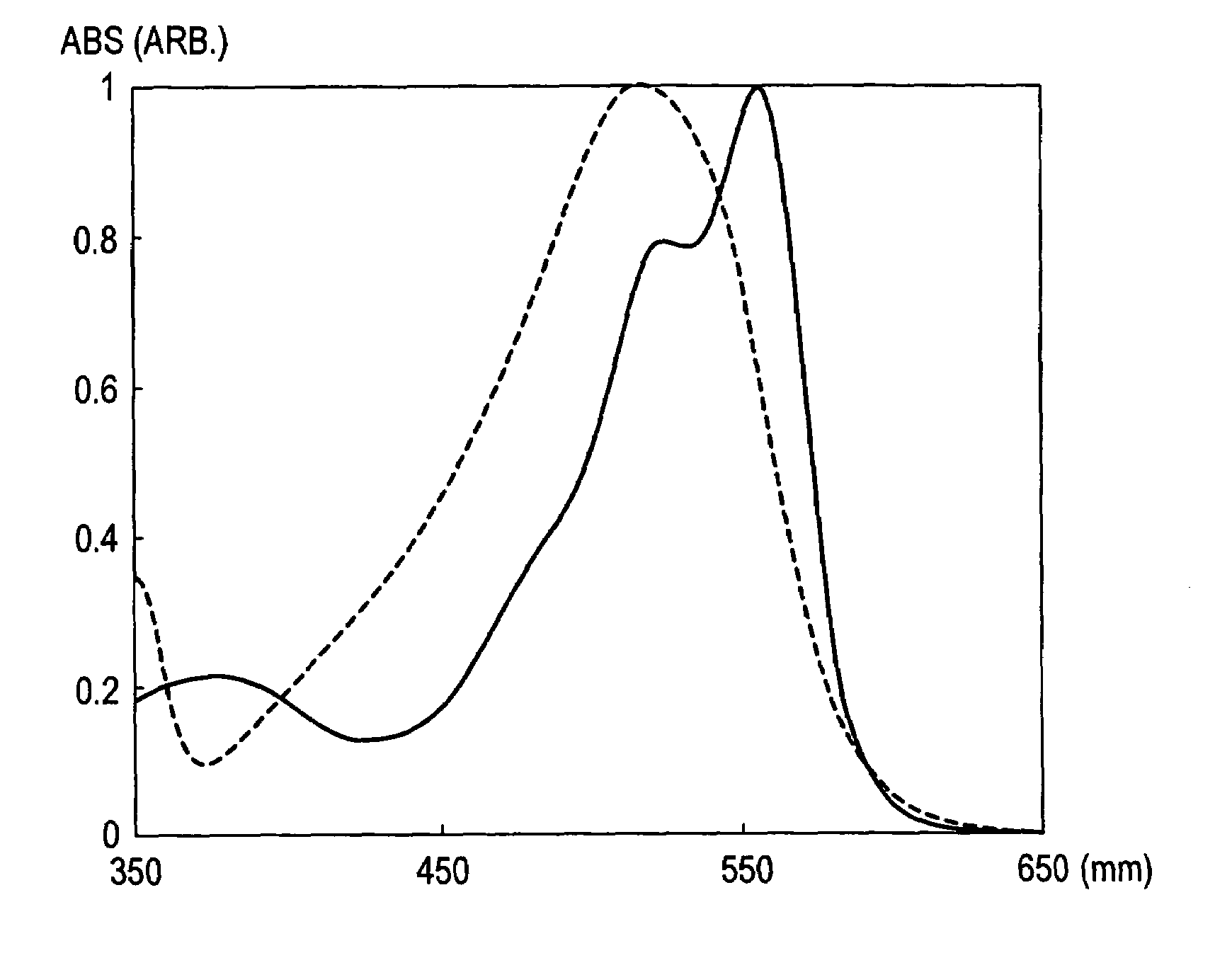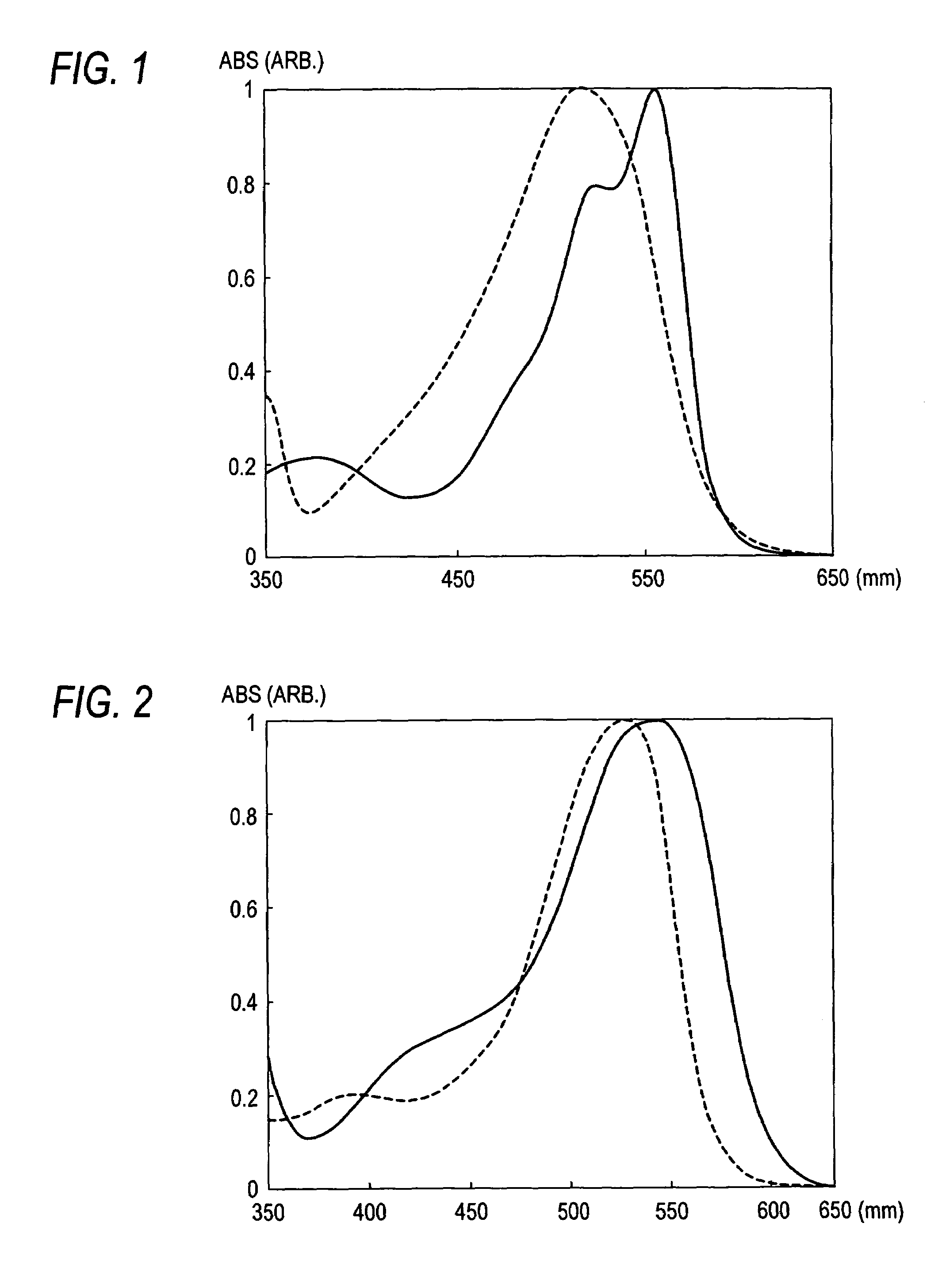Coloring composition for image formation and method for improving ozone resistance of color image
a color composition and composition technology, applied in the field of color composition for image formation, can solve the problems of reduced transparency or change in hue of transmitted light, difficulty in obtaining colorants meeting all these requirements, and inability to meet the requirements of color reproduction and fastness under various conditions of use, and achieve excellent hue and fastness.
- Summary
- Abstract
- Description
- Claims
- Application Information
AI Technical Summary
Benefits of technology
Problems solved by technology
Method used
Image
Examples
first preferred embodiment
[0057]In formula (1) representing the azo compound which preferably has at least one phosphono group and can be used in the first preferred embodiment of the present invention, A represents a residue of a 5-membered heterocyclic diazo component A—NH2. The hetero atom of the 5-membered hetero ring includes N, O, and S. The hetero ring as A is preferably a nitrogen-containing 5-membered heterocyclic ring. The hetero ring may have an aliphatic ring, an aromatic ring or a heterocyclic ring condensed therewith.
[0058]The hetero ring as A preferably includes a pyrazole ring, an imidazole ring, a thiazole ring, an isothiazole ring, a thiadiazole ring, a benzothiazole ring, a benzoxazole ring, and a benzisothiazole ring, each of which may have a substituent (s). Preferred are a pyrazole ring, an imidazole ring, an isothiazole ring, a thiadiazole ring, and a benzothiazole ring represented by formulae (a) to (f), respectively.
[0059]
wherein R7, R8, R9, R10, R11, R12, R13, R14, R15, R16, R17, R1...
synthesis example 1
Synthesis of Compound a-1
[0125]
1) Synthesis of Intermediate a-1a
[0126]5-Amino-3-t-butyl-4-cyanopyrazole (1) (8 g, 48.7 mmol), 15 ml of concentrated hydrochloric acid, and 50 ml of water were stirred at an inner temperature of 5° C. To the mixture was added 3.36 g (48.7 mmol) of sodium nitrite in divided portions over 10 minutes, followed by stirring at the same temperature for 10 minutes to form a diazonium salt. Separately, 21.3 g (40.6 mmol) of coupling component (2) was put into a three-necked flask, and 50 g of sodium acetate, 50 ml of dimethylformamide (DMF), and 50 ml of ethyl acetate were added and stirred. The diazonium salt solution was added dropwise to the mixture at an inner temperature of 5° C. over 10 minutes. After completion of the addition, the reaction mixture was stirred at that temperature for 30 minutes. A saturated aqueous sodium chloride solution (300 ml) was poured into the reaction mixture. The precipitate thus formed was collected by filtration to give 24.2...
synthesis example 2
Synthesis of Dye b-1
[0129]
[0130]One gram of compound b-1a was dispersed in 3.8 ml of a 2 / 3 (by volume) mixture of acetic acid and propionic acid, and the dispersion was cooled to 0° C. To the dispersion was slowly added 2.21 g of 41% nitrosylsulfuric acid, followed by stirring for 1 hour. Separately, 1.05 g of compound b-1b was dissolved in a mixture of 14 ml of DMF and 6 ml of ethyl acetate, and 2.5 g of sodium acetate was added thereto, followed by cooling to 0° C. The b-1a dispersion prepared above was added dropwise to the b-1b suspension. After the dropwise addition, the reaction mixture was further allowed to react for an additional 2 hours period. After completion of the reaction, water was added to the reaction mixture. The precipitated crystals were collected by filtration and purified by silica gel column chromatography to yield 750 mg (57.7%) of dye compound b-1.
[0131]λmax=545 nm
[0132]
[0133]One gram of compound b-6a was dispersed in 3.8 ml of a 2 / 3 (by volume) mixture of ...
PUM
| Property | Measurement | Unit |
|---|---|---|
| interfacial angle | aaaaa | aaaaa |
| interfacial angle | aaaaa | aaaaa |
| interfacial angle | aaaaa | aaaaa |
Abstract
Description
Claims
Application Information
 Login to View More
Login to View More - R&D
- Intellectual Property
- Life Sciences
- Materials
- Tech Scout
- Unparalleled Data Quality
- Higher Quality Content
- 60% Fewer Hallucinations
Browse by: Latest US Patents, China's latest patents, Technical Efficacy Thesaurus, Application Domain, Technology Topic, Popular Technical Reports.
© 2025 PatSnap. All rights reserved.Legal|Privacy policy|Modern Slavery Act Transparency Statement|Sitemap|About US| Contact US: help@patsnap.com



